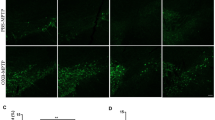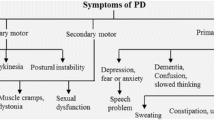Abstract
Extra-nigral central nervous system sites have been found to be affected in Parkinson’s disease (PD). In addition to substantia nigra, degeneration of spinal cord motor neurons may play a role in the motor symptoms of PD. To this end, hybrid rodent VSC 4.1 cells differentiated into motoneurons were used as a cell culture model following exposure to Parkinsonian neurotoxicant MPP+. SJA6017, a cell-permeable calpain inhibitor, was tested for its neuroprotective efficacy against the neurotoxicant. SJA6017 attenuated MPP+-induced rise in intracellular free Ca2+ and concomitant increases in the active form of calpain. It also significantly prevented increased levels of proteases and their activities, as shown by reduced levels of 145 kDa calpain-specific and 120 kDa caspase-3-specific spectrin breakdown products. Exposure to MPP+ elevated the levels of reactive oxygen species in VSC 4.1 motoneurons; this was significantly diminished with SJA6017. The motor proteins in spinal motoneurons, i.e., dynein and kinesin, were also impaired following exposure to MPP+ through calpain-mediated mechanisms; this process was partially ameliorated by SJA6017 pretreatment. Cytoprotection provided by SJA6017 against MPP+-induced damage to VSC 4.1 motoneurons was confirmed by restoration of membrane potential via whole-cell patch-clamp assay. This study demonstrates that calpain inhibition is a prospective route for neuroprotection in experimental PD; moreover, calpain inhibitor SJA6017 appears to be an effective neuroprotective agent against MPP+-induced damage in spinal motoneurons.





Similar content being viewed by others
Abbreviations
- dVSC 4.1:
-
Differentiated ventral spinal cord cells
- MTT:
-
3-(4, 5-Dimethythiazol-2-yl)-2,5-diphenyl tetrazolium bromide
- IR:
-
Immunoreactivity
- MPTP:
-
1-Methyl-4-phenyl-1,2,3,6-tetrahydropyridine
- PD:
-
Parkinson’s disease
- ROS:
-
Reactive oxygen species
- SBDP:
-
Spectrin breakdown products
- SC:
-
Spinal cord
References
Akdemir O, Uçankale M, Karaoğlan A, Barut S, Sağmanligil A, Bilguvar K, Cirakoğlu B, Sahan E, Colak A (2008) Therapeutic efficacy of SJA6017, a calpain inhibitor, in rat spinal cord injury. J Clin Neurosci 15:1130–1136
Arrington DD, Van Vleet TR, Schnellmann RG (2006) Calpain 10: a mitochondrial calpain and its role in calcium-induced mitochondrial dysfunction. Am J Physiol Cell Physiol 291:1159–1171
Azuma M, Shearer TR (2008) The role of calcium-activated protease calpain in experimental retinal pathology. Surv Ophthalmol 53:150–163
Banerjee R, Starkov AA, Beal MF, Thomas B (2009) Mitochondrial dysfunction in the limelight of Parkinson’s disease pathogenesis. Biochim Biophys Acta 1792:651–663
Banik NL, Hogan EL, Jenkins MG, McDonald JK, McAlhaney WW, Sostek MB (1983) Purification of a calcium-activated neutral proteinase from bovine brain. Neurochem Res 8:1389–1405
Bano D, Young KW, Guerin CJ, Lefeuvre R, Rothwell NJ, Naldini L, Rizzuto R, Carafoli E, Nicotera P (2005) Cleavage of the plasma membrane Na+/Ca2+ exchanger in excitotoxicity. Cell 120:275–285
Bevers MB, Neumar RW (2008) Mechanistic role of calpains in postischemic neurodegeneration. J Cereb Blood Flow Metab 28:655–673
Beyer RE (1992) An analysis of the role of coenzyme Q in free radical generation and as an antioxidant. Biochem Cell Biol 70:390–403
Biswas S, Harris F, Singh J, Phoenix DA (2004) The in vitro retardation of porcine cataractogenesis by the calpain inhibitor, SJA6017. Mol Cell Biochem 261:169–173
Butler JT, Samantaray S, Beeson CC, Ray SK, Banik NL (2009) Involvement of calpain in the process of Jurkat T cell chemotaxis. J Neurosci Res 87:626–635
Callizot N, Combes M, Henrigues A, Poindron P (2019) Necrosis, apoptosis, necroptosis, three modes of action of dopaminergic neuron neurotoxins. PLoS One 14:e0215277
Chu Y, Morfini GA, Langhamer LB, He Y, Brady ST, Kordower JH (2012) Alterations in axonal transport motor proteins in sporadic and experimental Parkinson’s disease. Brain 135:2058–2073
Cleeter MWJ, Cooper JM, Schapira AHV (1992) Irreversible inhibition of mitochondrial complex I by 1-methyl-4-phenylpyridinium: evidence for free radical involvement. J Neurochem 58:786–789
Crawford GD, Le WD, Smith RG, Xie WJ, Stefani E, Appel SH (1992) A novel N18TG2 x mesencephalon cell hybrid expresses properties that suggest a dopaminergic cell line of substantia nigra origin. J Neurosci 12:3392–3398
DeJongh KS, Colvin AA, Wang KK, Catterall WA (1994) Differential proteolysis of the full-length form of the L-type calcium channel alpha 1 subunit by calpain. J Neurochem 63:1558–1564
Desplats P, Lee HJ, Bae EJ, Patrick C, Rockenstein E, Crews L, Spencer B, Masliah E, Lee SJ (2009) Inclusion formation and neuronal cell death through neuron-to-neuron transmission of alpha-synuclein. Proc Natl Acad Sci 106:13010–13015
Dufty BM, Warner LR, Hou ST, Jiang SX, Gomez-Isla T, Leenhouts KM, Oxford JT, Feany MB, Masliah E, Rohn TT (2007) Calpain-cleavage of alpha-synuclein: connecting proteolytic processing to disease-linked aggregation. Am J Pathol 170:1725–1738
Goll DE, Thompson VF, Li H, Wei W, Cong J (2003) The calpain system. Physiol Rev 83:731–801
Grynkiewicz G, Poenie M, Tsien RY (1985) A new generation of Ca2+ indicators with greatly improved fluorescence properties. J Biol Chem 260:3440–3450
Hof PR, Glezer IL, Conde F, Flagg RA, Rubin MB, Nimchinsky EA, Vogt Weisenhorn DM (1999) Cellular distribution of the calcium-binding proteins parvalbumin, calbindin, and calretinin in the neocortex of mammals: phylogenetic and developmental patterns. J Cem Neuroanat 16:77–116
Inoue J, Nakamura M, Cui YS, Sakai Y, Sakai O, Hill JR, Wang KK, Yuen PW (2003) Structure-activity relationship study and drug profile of N-(4-fluorophenylsulfonyl)-L-valyl-L-leucinal (SJA6017) as a potent calpain inhibitor. J Med Chem 46:868–871
Inserte J, Garcia-Dorado D, Hernando V, Soler-Soler J (2005) Calpain-mediated impairment of Na+/K+-ATPase activity during early reperfusion contributes to cell death after myocardial ischemia. Circ Res 97:465–473
Kar P, Samanta K, Shaikh S, Chowdhury A, Chakraborti T, Chakraborti S (2010) Mitochondrial calpain system: an overview. Arch Biochem Biophys 495:1–7
Kass GE, Wright JM, Nicotera P, Orrenius S (1988) The mechanism of 1-methyl-4-phenyl-1,2,3,6-tetrahydropyridine toxicity: role of intracellular calcium. Arch Biochem Biophys 260:789–797
Kopil CM, Siebert AP, Foskett JK, Neumar RW (2012) Calpain-cleaved type 1 inositol 1,4,5-trisphosphate receptor impairs ER Ca(2+) buffering and causes neurodegeneration in primary cortical neurons. J Neurochem 123:147–158
Kumar P, Choonara YE, Pillay V (2014) In silico affinity profiling of neuroactive polyphenols for post-traumatic calpain inactivation: a molecular docking and atomistic simulation sensitivity analysis. Molecules 20:135–168
Kupina NC, Nath R, Bernath EE, Inoue J, Mitsuyoshi A, Yuen PW, Wang KK, Hall ED (2001) The novel calpain inhibitor SJA6017 improves functional outcome after delayed administration in a mouse model of diffuse brain injury. J Neurotrauma 18:1229–1240
Levesque S, Wilson B, Gregoria V, Thorpe LB, Dallas S, Polikov VS, Hong JS, Block ML (2010) Reactive microgliosis: extracellular micro-calpain and microglia-mediated dopaminergic neurotoxicity. Brain 133:808–821
Mandavilli BS, Ali SF, Van Houten B (2000) DNA damage in brain mitochondria caused by aging and MPTP treatment. Brain Res 885:45–52
Mizuno Y, Sone N, Saitoh T (1987) Effects of 1-methyl-4-phenyl-1,2,3,6-tetrahydropyridine and 1-methyl-4-phenylpyridinium ion on activities of the enzymes in the electron transport system in mouse brain. J Neurochem 48:1787–1793
Mizuno Y, Ohta S, Tanaka M, Takamiya S, Suzuki K, Sato T, Oya H, Ozawa T, Kagawa Y (1989) Deficiencies in complex I subunits of the respiratory chain in Parkinson’s disease. Biochem Biophys Res Commun 163:1450–1455
Nicholls DG, Vesce S, Kirk L, Chalmers S (2003) Interactions between mitochondrial bioenergetics and cytoplasmic calcium in cultured cerebellar granule cells. Cell Calcium 34:407–424
Nicklas WJ, Youngster SK, Kindt MV, Heikkila RE (1987) MPTP, MPP+ and mitochondrial function. Life Sci 40:721–729
Ozaki T, Tomita H, Tamai M, Ishiguro S (2007) Characteristics of mitochondrial calpains. J Biochem 142:365–376
Parker WD Jr, Parks JK, Swerdlow RH (2008) Complex I deficiency in Parkinson’s disease frontal cortex. Brain Res 1189:215–218
Przedborski S, Jackson-Lewis V, Djaldetti R et al (2000) The parkinsonian toxin MPTP: action and mechanism. Restor Neurol Neurosci 16:135–142
Samantaray S, Knaryan VH, Le Gal C, Ray SK, Banik NL (2011) Calpain inhibition protected spinal cord motoneurons against 1-methyl-4-phenylpyridinium ion and rotenone. Neuroscience 192:263–274
Samantaray S, Knaryan VH, Shields DC, Cox AA, Haque A, Banik NL (2015) Inhibition of Calpain activation protects MPTP-induced nigral and spinal cord neurodegeneration, reduces inflammation, and improves gait dynamics in mice. Mol Neurobiol 52:1054–1066
Schapira AHV, Cooper JM, Dexter D, Clark JB, Jenner P, Marsden CD (1990) Mitochondrial complex I deficiency in Parkinson’s disease. J Neurochem 54:823–827
Sherer TB, Betarbet R, Greenamyre JT (2002) Environment, mitochondria, and Parkinson’s disease. Neuroscientist 8:192–197
Smith MA, Schnellmann RG (2012) Calpains, mitochondria, and apoptosis. Cardiovasc Res 96:32–37
Smith PD, Mount MP, Shree R, Callaghan S, Slack RS, Anisman H, Vincent I, Wang X, Mao Z, Park DS (2006) Calpain-regulated p35/cdk5 plays a central role in dopaminergic neuron death through modulation of the transcription factor myocyte enhancer factor 2. J Neurosci 26:440–447
Takeshige K, Minakami S (1979) NADH- and NADPH-dependent formation of superoxide anions by bovine heart submitochondrial particles and NADH-ubiquinone reductase preparation. Biochem J 180:129–135
Tanner CM (2003) Is the cause of Parkinson’s disease environmental or hereditary? Evidence from twin studies. Adv Neurol 91:133–142
Vosler PS, Brennan CS, Chen J (2008) Calpain-mediated signaling mechanisms in neuronal injury and neurodegeneration. Mol Neurobiol 38:78–100
Warner TT, Schapira AH (2003) Genetic and environmental factors in the cause of Parkinson’s disease. Ann Neurol 53:S16–S23
Warren MW, Zheng W, Kobeissy FH, Cheng Liu M, Hayes RL, Gold MS, Larner SF, Wang KK (2007) Calpain- and caspase-mediated alphaII-spectrin and tau proteolysis in rat cerebrocortical neuronal cultures after ecstasy or methamphetamine exposure. Int J Neuropsychopharmacol 10:479–489
Zhao H, Xu M, Chu G (2017) Association between myocardial cell apoptosis and calpain-1/caspase-3 expression in rats with hypoxic-ischemic brain damage. Mol Med Rep 15:2727–2731
Acknowledgments
The hybrid cell line VSC 4.1 was a gift from Dr. Stanley H. Appel (Houston, TX, USA).
Code Availability
Not applicable.
Funding
This work was supported in part by NIH-NINDS (R01NS062327-01A2), Veterans Administration (1I01BX004269-01), and the South Carolina State Spinal Cord Research Fund (SCIRF-2015P-01, SCIRF-2015P-04, SCIRF-2015-I-01, SCIRF-2016 I-03, and SCIRF #2018 I-01).
Author information
Authors and Affiliations
Corresponding author
Ethics declarations
Conflict of Interest
The authors declare that they have no conflicts of interest.
Ethics Approval
No human or animal subjects were included in this study.
Consent to Participate
Not applicable.
Consent for Publication
Not applicable.
Additional information
Publisher’s Note
Springer Nature remains neutral with regard to jurisdictional claims in published maps and institutional affiliations.
Rights and permissions
About this article
Cite this article
Samantaray, S., Knaryan, V.H., M. Del Re, A. et al. Cell-Permeable Calpain Inhibitor SJA6017 Provides Functional Protection to Spinal Motoneurons Exposed to MPP+. Neurotox Res 38, 640–649 (2020). https://doi.org/10.1007/s12640-020-00264-3
Received:
Revised:
Accepted:
Published:
Issue Date:
DOI: https://doi.org/10.1007/s12640-020-00264-3




